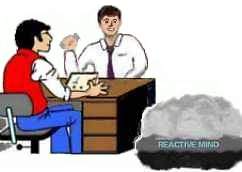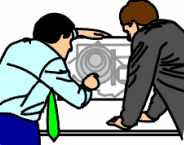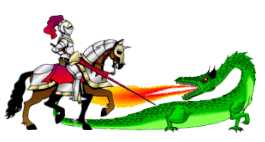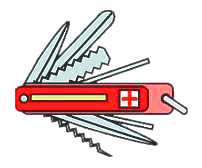|
|
|
 |
A Time Machine may be fantasy
but Time Travel into the distant past
gets a new meaning with Engram
running. The pc is returned to incidents
of his past and made to relive them
with all the original perceptions. He can
recover past experiences
with an amazing number of details.
|
A little Primer and
Short History of Engram running
Engram Running. Techniques used to run
Engrams with. Also the activity of applying these techniques to a pc.
Engram Clearing. This is ST Grade 5 -
Engram Clearing. It uses Engram running by Chains, Routine-3-RA as its
main process.
|

|
"The Reactive Mind consists of Pictures"
- It is full of recordings
of bad experiences and incidents. These are very
accurately
recorded but hard to reach.
The types of incidents are:
|
|

|
Engrams:
A 'film clip' in the mind
of an accident is a typical Engram. Here a motor cycle
accident. The victim recorded what happened - even when
'unconscious'.
It contains Pain and Unconsciousness.
|
Engram
is a mental image picture of an experience containing pain,
unconsciousness, and a real or fancied threat to survival. It is a
recording in the Reactive Mind of something which actually happened to
an individual in the past and which contained pain and
unconsciousness, both of which are recorded in the mental image
picture called an Engram.
It must, by definition, have impact or injury as part of its content.
The Engram is a complete recording, down to the last accurate detail,
of every perception present in a moment of partial or full
unconsciousness.
|

|
Secondaries:
A 'film clip' in the mind
of a loss - like one's motor cycle stolen
and damaged.
It contains Loss and Mis-emotion.
|
Secondary
A Secondary is a mental image picture of a moment of severe and
shocking loss or threat of loss which contains misemotion such as
anger, fear, grief, apathy or "deathfulness." It is a mental
image picture recording of a time of severe mental stress. It may
contain unconsciousness.
|

|
Locks:
A 'film clip' in the mind
of a reminder of the Engram or Secondary.
Here the red scooter
restimulates the pc's
bad experiences with
motor cycles.
It's a
Reactive Reminder.
|
Lock
A mental image picture of an incident where one was knowingly or
unknowingly reminded of a Secondary or Engram. It does not itself
contain a blow or a burn or impact and is not any major cause of
misemotion. It does not contain unconsciousness. It may contain a
feeling of pain or illness, etc., but is not itself the source of it.
A Lock is a mental image picture of a non-painful but disturbing
experience the person has experienced and which depends for its force
on an earlier Secondary and Engram which the Lock-experience has
restimulated.
|

|
Engram Running:
When you run an
incident the pc is made
to relive each 'film clip'
in great detail. You
usually have to run a
Chain of incidents going back in time. You run one incident, find
an earlier one; run that one, etc., until you find the first
one...
|
Chain
A series of incidents of similar nature or similar subject matter.
Chain of incidents
A whole adventure or activity related by the same subject, general
location or people, understood to take place in a finite time period,
weeks, months, years or even billions or trillions of years. Each
incident (such as "a time you rode your motor cycle") is a
short period, but related to earlier incidents. Together they make up
one Chain.
|

|
Erasure:
Going down a Chain
of Incidents and going through
the Basic Engram many times
will rub it out and empty it for reactive content. It has been
erased and the Chain is gone.
|
Erase
To go over an Engram repeatedly until it has vanished
entirely. There is a distinct difference between reducing an
incident and an erasure. Erasure is accomplished when you find
the earliest part of the earliest incident on a Chain and get the
postulate made at the time.
When the postulate comes off the incident will be erased. (The
incident can still be remembered, but now it is an analytical
experience).
Short History
1950 - Engram running was first
released to the public in R. Hubbard's best-selling book, "Dianetics™,
the Modern Science of Mental Health." Students flocked to this new
activity and was taught to audit Locks, Secondaries and Engrams on each
other. The method taught in the book is still in use as it is quite
effective and easy to teach. Originally the pc would lie on a couch,
psycho-analysis style. No Meter was used.
 |
Engram running in 1950
was originally done
with the pc lying down
- psycho-analysis style.
|
1951 - R. Hubbard discovered,
that "past lives" could be contacted with Engram techniques.
Later many other techniques were developed and Engram running went out of
use.
1952 - The book "A History
of Man" was released. It is an amazing account of Man's history
as it can be viewed through auditing. Many pre-Earth incidents were
contacted and mapped out.
1959 - The book, "Have you
lived before this Life?" was released. The book contains a detailed
record of incidents contacted in Engram running by many different pc's.
Engram running had a short renaissance around this time, but went out of
use again.
1963 - There was some work with
dating Engrams and find their duration as a method of contacting
whole-track incidents. It later (1969) became part of Routine 3R, Engram
running by Chains.
1966 - Engram running. An
updated version of Engram running per "Dianetics™, the Modern
Science of Mental Health" was released. It was taught to new student
auditors as a way to get familiar with auditing and the mechanics of the
mind. Running Secondaries and Engrams was an early auditing action, done
on new pc's.
 |
With Engram running using
R-3-R (1969) and later R-3-RA
(1978) the Time Track suddenly
opened up to most pc's. The Time
Track is the complete picture
record of the pc's past.
|
1969 - Standard Dianetics™
was released and was a big 'Hit' for a number of years. It was audited as
the first major Grade on relatively new pc's. It was done before Grade 0.
Routine 3-R, Engram running by Chains was the central process used. Many
different ways of locating Chains to run were used. Auditors were
assessing for emotions, feelings, somatics, pains, aches and attitudes
connected to a subject in question. Such a sensation, etc. could be
tracked down on an Engram Chain until the basic incident was contacted. By
going through the basic incident many times it would erase. The mental
image picture, containing that particular somatic, etc. would be 'rubbed
out' or erased (As-ised in the language of the Axioms). Subjects
used could be use of drugs, study, and many others. The most important
tool in finding Chains was a general listing of these somatics and
attitudes on the so-called Health Form. Any way Chains could be
located was of interest. Pc's would quickly contact the whole-track and
the tales around the activity were amazing, entertaining and sometimes
enlightening.
1974 - Expanded Dianetics™
was released. The central process, R-3-R was here used to handle evil
purposes. These could be traced back in time on an Engram Chain and the
basic incident found and erased, causing the evil purpose to As-is.
1978 -
NED - New Era Dianetics™ was released. The central process was an
update of R-3-R, now called R-3-RA. One of the major changes was going for
the Postulate in the basic incident. It was found there was a basic
postulate behind an engramic Chain that actually held it in place. The
rule was "Postulate off = Erasure". NED uses Meter Assessment to
a large extent. This makes it a very precise and fast action compared to
Standard Dianetics, but it also demands excellent Meter skills on the part
of the auditor.
 |
Postulate off=Erasure
was the big discovery in 1978.
Unless you get to the very bottom
of things - like the earlier beginning
- the thing isn't handled completely.
When you get to the tip of the roots
and get the postulate off you are done!
You have "completely removed
the whole root system of the weed".
|
1981 - Dianetics™ Clear. It
was also found, that a majority of pc's would actually go Clear on running
Dianetics. This had apparently happened in great number since 1969 (and
even earlier on 1950 style). When this was clearly established it sorted
out a lot of problems, confusions and mystery cases. Pc's audited on
Engrams after attaining Clear had run into a lot of problems and odd
phenomena.
Following this discovery NED was made
into a Grade done after Grade 4. Its use became more restricted as it also
was recognized it was better done on pc's after their Grades 0-4.
Grades 0-4 Versus Engram Running
One of the major differences between the Grade processes of 0-4 and Engram
running is, that most Grade 0-4 and repair processes take the subject to a
state of key-out or release, while Engram running erases the basic
incident and the postulate behind the difficulty. When something is taken
to key-out only, it may key in again later and again bother the pc. But
with the gradient approach of doing the Grades 0-4 first and then Engram
running the pc is ensured wins all the way and final victory in the form
of the state of Clear.
 |
 |
 |
|
Big Bank - Small PC
something has to be done!
|
Grade 0-4; Positive Gains:
Increased ability.
PC gets bigger. Bank
keys out and seems small.
|
Running Engrams
- Negative Gains, erasing
things. Bank made smaller.
PC seems bigger.
|
The Grades 0-4 concentrate on
increasing the pc's abilities. They go for positive gain (as a rule). It
makes the pc bigger. Engram running erases the negative incidents and
disabilities caused by them. That is progress by 'absence of' barriers and
disabilities - often called 'Negative gain'. It makes the Bank smaller.
Both approaches are necessary for optimum gains.
Recall
Versus Returning
Engram Clearing has its own set of Axioms, the Dianetics™ Axioms of
1951. But in terms of the 1954
Scn Axioms, listed in ST0, the difference between Engram running and
recall can be understood this way:
1. Recall: Pc is made to
communicate with his past and the pictures in the Bank.
Cause-distance-Effect is the basic comm formula. The pc is in present
time, the pictures are in the past. By getting the communication formula
established, the pc becomes Cause, the pictures Effect and the pc
establishes the correct distance, including distance in time. The Bank
keys out and moves away.
2. Engram running: The pc is returned to the incident - as
if it was happening right now. By doing this you take advantage of his
ability to make a perfect duplicate. It is best defined in Axiom 20. The
'Object' in this case is the engramic incident:
"Bringing the static (pc) to
create a perfect duplicate causes the vanishment of any existence or part
thereof. A perfect duplicate is an additional creation of the object, its
energy and space, in its own space, in its own time, using its own energy.
This violates the condition that two objects must not occupy the same
space, and causes a vanishment of the object".
In terms of the Scn Axioms, that is
what Erasure means, a perfect duplicate. The downside is, that there are
millions of such incidents. The approach thus is, (1) to key out wholesale
parts of the Bank. (2) To fully erase the most resistive and nasty
incidents.
 |
The State of Clear is
routinely attained on
Engram Clearing after Grade 4.
Things are permanently
erased with R-3-RA.
Clear is a state, where the pc no
longer has a Reactive Mind ('Bank').
The whole Bank basically gets
erased permanently. This results
in greater well being, better
performance and greater interest in life.
|
|























